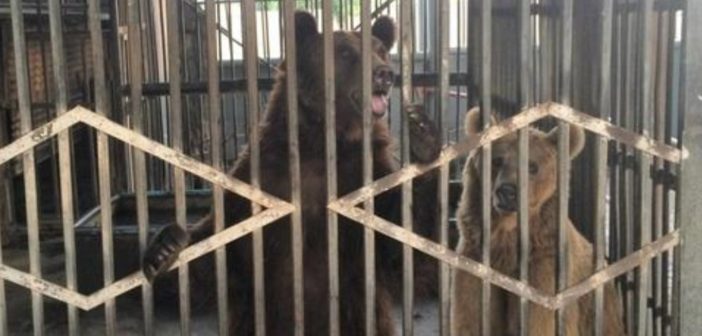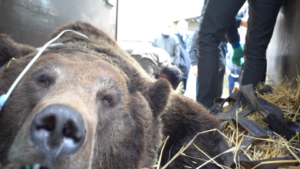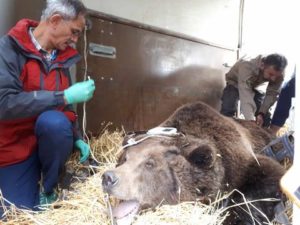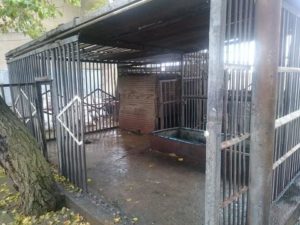Last Friday, November 23rd, we joined with our partner, The Foundation for the Preservation of Wildlife and Cultural Assets (FPWC), to take on the rescue of two caged bears living in horrific conditions at a bus depot.
It took a year to overcome the obstacles to setting these two bears free. While we fought for their release, the poor animals languished in their filthy, barren prison, gazing through the bars at the world outside.
Finally, all obstacles were overcome and we were able to plan for the rescue. The male, a Siberian brown bear, weighed in at 500 kilograms [about 1100 pounds] and was far too large for our transport crates. The decision was made to transport him in a horse trailer with the central partition removed. The second bear, a smaller female Syrian brown bear, was to be transported by the usual means, on a deep bed of straw in a transport crate.
The rescue operation involved a team of four vets from Armenia, Iran and the United Kingdom, with the vital assistance of the local emergency rescue services. Once the male bear had been deftly anesthetized with a blow dart, the emergency rescue crew set about cutting through the iron bars of the cage. The cage door had been welded up long ago – a clear indication that, had it not been for our rescue operation, those two bears would have lived in that ghastly cage until the day they died.
Once the male bear was safely asleep, the medical team moved in swiftly to monitor him and prepare him for the journey to his new home at our rescue center in the mountains. Meanwhile, veterinarian Iman moved on to anesthetizing the little female bear, who had been shut into a tiny, dark cave-like area off the main cage. She had been shut in there to make the rescue possible, but it seems this poor little bear had spent months locked in this dank hell-hole when she gave birth to a cub. The ceiling was so low that she could barely stand up and it was knee-deep in feces. The conditions these two bears had been living in for years were the stuff of nightmares.
It seems the male bear had been born in that cage and has only ever known life behind bars, kept for the idle entertainment of his captor as nothing more than a living trophy.
It was a momentous moment when the emergency rescue crew cut through the bars and removed the front section of the cage. The trailer was reversed into place so that a team of ten men could lift the huge bulk of the male bear into the back of it. The female was carried more easily into the transport crate and then into the rescue vehicle. With three vets in the trailer monitoring the sleeping male bear and one vet watching over the female, the rescue vehicles, accompanied by the emergency rescue crew with lights flashing, set off in convoy on the 45 minute journey to our rescue center. With a sleeping bear lying loose in the back of a trailer and three vets sitting by his side, it was vital that there were no hold-ups on the route that would allow time for the rescued bear to wake from his slumber!
Fortunately, the journey went smoothly and even the final bumpy stretch up to the gates of the center did not wake the bears from their deep sleep. On arrival, a team from FPWC were ready and waiting to carry the bears to their quarantine quarters where a soft bed of straw awaited them.
The vets again moved in to check on the two sleeping bears and reassured the rest of the team that they were absolutely fine and enjoying what was undoubtedly the most comfortable bed they had ever had to sleep on. Some hours later both bears slowly woke up in their new home. In the days ahead they will be given constant care and attention as they adjust to their surroundings and start a new life free from the misery and neglect they have suffered from for so long.
After taking part in the rescue mission, IAR CEO Alan Knight said, “This has been an extremely emotional day for everyone involved in this rescue operation. The two bears were being kept in absolutely shocking conditions and we were all desperate to set them free. We knew the rescue would be a particularly challenging one because of the size of the male bear. He is undoubtedly the biggest bear we have rescued to date. So there was great euphoria among the team when the bears were safely installed in their new quarters.
“I can’t thank our supporters enough for helping to make this rescue operation possible. We simply couldn’t have done it without them. Now it’s a case of giving the bears the treatment and care they have been deprived of for so long. They have a long road to complete recovery and we hope our supporters will continue to stand by us as we work to give them the healthy, happy lives they deserve.”
Featured image: The two bears, pre-rescue, in the cage they lived in for 14 years. This image and all images in this story credited to IAR.








